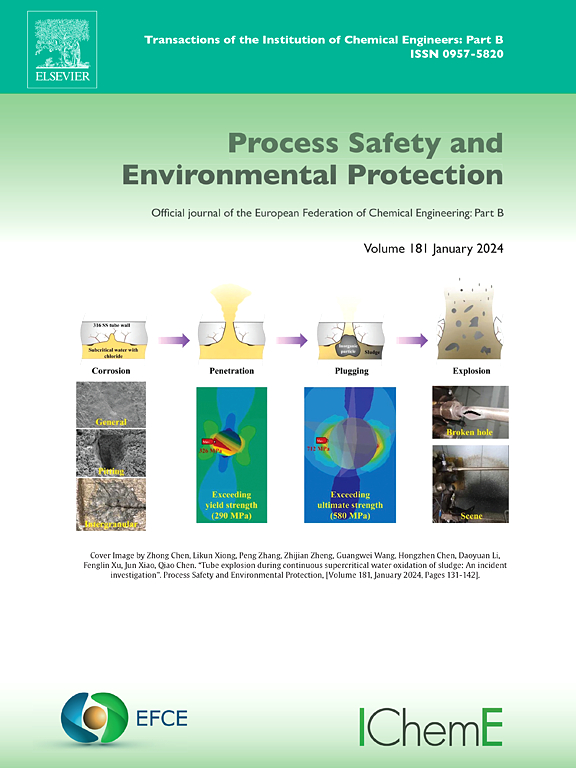Disposal of reactive compounds and salts in secondary aluminum dross: A critical review
IF 6.9
2区 环境科学与生态学
Q1 ENGINEERING, CHEMICAL
引用次数: 0
Abstract
Massive secondary aluminum dross is annually produced globally, posing a serious threat to the environment. Existing reviews have mainly focused on alumina extraction and material preparation methods, neglecting toxic properties. In this study, its environmental impact was analyzed, and disposal of reactive compounds and salts in secondary aluminum dross were reviewed. The harmful effects of alumina result from their reactivity and salt content; the former can be eliminated hydrolysis and high-temperature oxidation, and the latter may be separated via aqueous washing and high-temperature evaporation. Solution washing can efficiently remove chloride and produce a gas mixture composed mainly of hydrogen and ammonia, and containing some toxic gas. High-temperature elimination can be implemented in the ways, oxidizing by oxygen or the oxides in hazardous wastes and flue gas, and acting as foaming agent for fabricating aerated concrete and foaming ceramic. However, these methods risk generating harmful gases, fail to fully utilize the reducibility of aluminum nitride and metallic aluminum in the dross, and overlook integrated considerations of reducibility, salt separation, and resource planning. Consequently, a method for recycling aluminum dross has been proposed. Thus, a cyclic method for utilizing the dross is proposed. The dross is processed at high-temperature for separating salt and producing ladle refining slag. The obtained salt is returned to aluminum industry, and the slag is used in the process of steel refining. The spent slag can be utilized as raw material for alumina preparation, and the alumina can be reused in aluminum industry. This method fully considers the utilization of the reducibility and composition of the dross, maximizing its economic value while minimizing environmental impacts.
二次铝渣中活性化合物和盐的处理:综述
全球每年产生大量的二次铝渣,对环境造成严重威胁。现有的综述主要集中在氧化铝的提取和材料制备方法上,而忽略了其毒性。本文分析了铝渣对环境的影响,并对铝渣中活性化合物和盐的处理进行了综述。氧化铝的有害影响来自其反应性和含盐量;前者可通过水解和高温氧化消除,后者可通过水洗和高温蒸发分离。溶液洗涤可以有效地去除氯化物,产生以氢和氨为主的气体混合物,并含有一些有毒气体。高温消除可以通过氧气或危险废物和烟气中的氧化物氧化的方式实现,并作为制造加气混凝土和发泡陶瓷的发泡剂。但这些方法存在产生有害气体的风险,未能充分利用渣中氮化铝和金属铝的还原性,忽略了还原性、盐分离和资源规划的综合考虑。为此,提出了一种回收铝渣的方法。因此,提出了一种循环利用渣滓的方法。对渣进行高温处理,分离盐,生产钢包精炼渣。得到的盐返回铝工业,炉渣用于炼钢。废渣可作为制备氧化铝的原料,氧化铝可在铝工业中重复利用。该方法充分考虑了废渣可还原性和成分的利用,使其经济价值最大化,同时使环境影响最小化。
本文章由计算机程序翻译,如有差异,请以英文原文为准。
求助全文
约1分钟内获得全文
求助全文
来源期刊

Process Safety and Environmental Protection
环境科学-工程:化工
CiteScore
11.40
自引率
15.40%
发文量
929
审稿时长
8.0 months
期刊介绍:
The Process Safety and Environmental Protection (PSEP) journal is a leading international publication that focuses on the publication of high-quality, original research papers in the field of engineering, specifically those related to the safety of industrial processes and environmental protection. The journal encourages submissions that present new developments in safety and environmental aspects, particularly those that show how research findings can be applied in process engineering design and practice.
PSEP is particularly interested in research that brings fresh perspectives to established engineering principles, identifies unsolved problems, or suggests directions for future research. The journal also values contributions that push the boundaries of traditional engineering and welcomes multidisciplinary papers.
PSEP's articles are abstracted and indexed by a range of databases and services, which helps to ensure that the journal's research is accessible and recognized in the academic and professional communities. These databases include ANTE, Chemical Abstracts, Chemical Hazards in Industry, Current Contents, Elsevier Engineering Information database, Pascal Francis, Web of Science, Scopus, Engineering Information Database EnCompass LIT (Elsevier), and INSPEC. This wide coverage facilitates the dissemination of the journal's content to a global audience interested in process safety and environmental engineering.
 求助内容:
求助内容: 应助结果提醒方式:
应助结果提醒方式:


